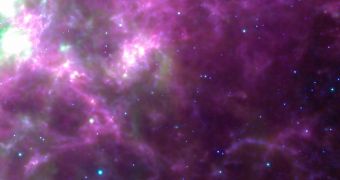Astronomers using the European Space Agency's (ESA) Herschel Space Observatory announce the discovery of massive volumes of dust in supernova remnants. The finding confirms the theory which holds that the violent death of massive stars is responsible for seeding heavy elements in the Cosmos.
Determining which mechanism spreads chemicals heavier than hydrogen and helium around has been a complex challenge. Experts needed to wait until suitable, advanced technologies became available to study the vast expanses of space contained in supernova nebulae.
According to theory, heavy chemical elements can only form from hydrogen and helium under the extreme conditions of a stellar explosion, when a massive star's core collapses to form either a neutron star or a black hole.
One of the most important things that needed to exist in order for this theory to be true was the existence of large quantities of dust formed by supernova events. However, previous studies failed to identify more than a fraction of the dust theory called for.
But the recent observations conducted using Herschel lead to the discovery of vast amounts of dust, hundreds of thousands of times more than anything that had been seen before, Space reports.
The reason why other investigations failed to see the dust is that the stuff is extremely cold. Herschel was able to see it because it is the most sensitive and complex space telescope ever built, featuring the capability to conduct extremely precise measurements in far-infrared and submillimeter wavelengths.
While studying the young supernova SN1987A, Herschel's operators noticed the dust surrounding the former massive star. The object is located in the dwarf galaxy Large Magellanic Cloud, one of the Milky Way's closest neighbors.
The dust itself was more than 300 degrees Fahrenheit (160 degrees Kelvin) cooler than what other telescopes had picked up before. In other words, the other instruments only saw the tip of the iceberg.
“This discovery was actually surprising. We did not intend to observe this particular object,” explains Mikako Matsuura, the primary author of the new study, and an astronomer at the University College London (UCL).
He explains that each supernova must produce between 1/10 and 1 solar mass of dust, in order to account for all the dust that can be seen inside galaxies today. The new study shows that this is indeed the case, as suggested years ago.
“This is the first time anything approaching that amount has been found in a supernova,” adds astronomer Mike Barlow, who holds an appointment at the Open University. Details of the new work appear in the July 7 online issue of the top journal Science.
“The detection by Herschel of a half a solar mass of dust in the ejecta of SN 1987A provides the first reliable evidence that supernovae from high mass stars can account for the amounts of dust seen in these [early] galaxies, and that they probably still make an important contribution,” Barlow concludes.

 14 DAY TRIAL //
14 DAY TRIAL //